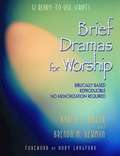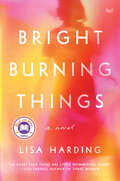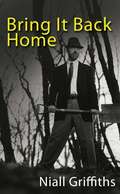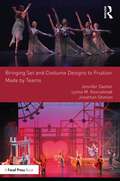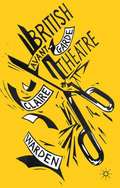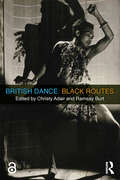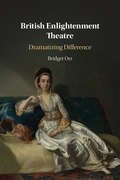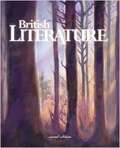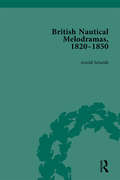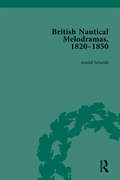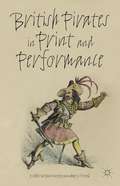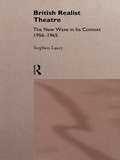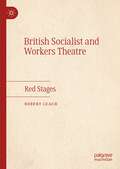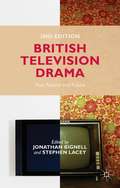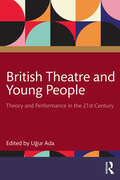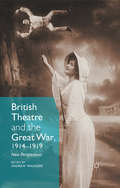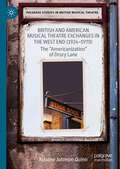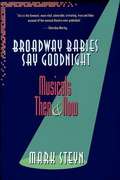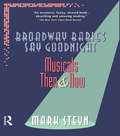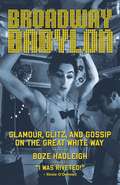- Table View
- List View
Brief Dramas for Worship: 12 Ready-to-Use Scripts
by Karen F. Miller Brenda M. NewmanBrief Dramas for Worship provides dramas that are suitable for both contemporary and traditional worship services. They are appropriate for use instead of a sermon, or as the sermon. Included are questions and comments to use in a discussion following the service so that key insights from the biblical drama can be emphasized. The scripts do NOT require memorization. Each drama includes extensive "helps" which identify possible sets, simple costumes, and a detailed worship outline, including hymn and praise song suggestions, original prayers, etc. These production notes provide effective, professional presentation instructions.Permission is granted to reproduce scripts for use in congregational settings. Most of these biblically-based dramas offer a woman's point of view about a scripture story or a scripture message. Some of the "main characters" are biblical people and others are contemporary people. Dramas include: The Bethlehem Child; Margaret, a Grieving Mother Yearns for Her Wayward Son (Hosea 11:1); Bath Sheba and David; Lydia, Pilate's Wife; Martha, Prescription for Peace; Caroline: A Waitress Receives the Living Water; Eli's Wife: A Husband's Tale Brings Hope for Peace; and, Mattie May: A Mountain Woman's Tale of Gracious Plenty.
Briefe aus der Antarktis
by Federico RomanoDie Lebensreise eines selbstlosen und großzügigen Mannes durch Schmerz, Freude, Freundschaft, Liebe und Tod. "Briefe aus der Antarktis" Die Lebensreise eines selbstlosen und großzügigen Mannes durch Schmerz, Freude, Freundschaft, Liebe und Tod. Das ist "Briefe aus der Antarktis", Ein Roman, der auf einer Insel der Fantasie spielt, die mehr ein Ort der menschlichen Seele ist.Die menschliche Seele, die hier erzählt wird, ist Frederik Jonson. Seine Begegnungen, die harten Lebenserfahrungen, mit denen er fertig werden kann und mit denen er fertig werden kann, machen sein Leben von Anfang an zunichte. Er wurde von der Mutter verlassen, die er nie wieder sehen wird. Aber es ist genau der Traum der Mutter, die Sie noch nie getroffen hat, dass Sie sich ständig formt, dass sie für die, die sie braucht, "Mutter" wird, bis zum letzten Tag ihres Lebens, wenn Sie Ihr Baby holt, um es auf die letzte und wichtigste Reise zu bringen. Beispieltext: Die Lebensreise eines selbstlosen und großzügigen Mannes durch Schmerz, Freude, Freundschaft, Liebe und Tod. Das ist "Briefe aus der Antarktis", Ein Roman, der auf einer Insel der Fantasie spielt, die mehr ein Ort der menschlichen Seele ist. Die menschliche Seele, die hier erzählt wird, ist Frederik Jonson. Seine Begegnungen, die harten Lebenserfahrungen, mit denen er fertig werden kann und mit denen er fertig werden kann, machen sein Leben von Anfang an zunichte.
Bright Burning Things: A Novel
by Lisa HardingA READ WITH JENNA BOOK CLUB PICK AS FEATURED ON TODAY * A PEOPLE MAGAZINE PICK * AN INDIE NEXT PICK * A LIBRARYREADS PICK *AN AMAZON EDITORS PICK “On every page there are little shimmering bombs. Like Room, where parenthood is at once your jail and your salvation, it is almost claustrophobic—but in the most glorious way.”—Lisa Taddeo, #1 New York Times bestselling author of Three Women and AnimalA rising international literary star makes her American debut with this visceral, tender, and brave portrait of addiction, recovery, and motherhood, as harrowing and intense as Shuggie Bain.Sonya used to perform on stage. She used to attend glamorous parties, date handsome men, ride in fast cars. But somewhere along the way, the stage lights Sonya lived for dimmed for good. In their absence, came darkness—blackouts, empty cupboards, hazy nights she can't remember.What keeps Sonya from losing herself completely is Tommy, her son. But her immense love for Tommy is in fierce conflict with her immense love of the bottle. Addiction amplifies her fear of losing her child; every maternal misstep compels her to drink. Tommy’s precious life is in her shaky hands. Eventually Sonya is forced to make a choice. Give up drinking or lose Tommy—forever.Bright Burning Things is an emotional tour-de-force—a devastating, nuanced, and ultimately hopeful look at an addict’s journey towards rehabilitation and redemption.A MOST ANTICIPATED BOOK FROM: Washington Post, The Millions, PopSugar, Shondaland, Good Morning America, Nylon, Good Housekeeping, Town & Country
Brighton Beach Memoirs
by Neil SimonFourteen-year-old Eugene is preoccupied by his passion for the Yankees and his lust for his beautiful cousin, Nora. Eugene's comic growing pains contrast with the darker issues troubling his family: poverty, illness and the growing Nazi threat to relatives in Europe.
Bring it Back Home (Quick Reads Ser.)
by Niall GriffithsChased by a hit-man, a young man returns home from London to a small town in Wales. Reconciliation with his family is alternated with his pursuer’s progress. A long criminal connection is revealed but can he escape the sins of his fathers? This is a tense, tightly written drama that will captivate the reader with fast, gut-wrenching action.
Bring it Back Home (Quick Reads)
by Niall GriffithsChased by a hit-man, a young man returns home from London to a small town in Wales. Reconciliation with his family is alternated with his pursuer’s progress. A long criminal connection is revealed but can he escape the sins of his fathers? This is a tense, tightly written drama that will captivate the reader with fast, gut-wrenching action.
Bringing Set and Costume Designs to Fruition: Made by Teams
by Jennifer Dasher Lynne M. Koscielniak Jonathan ShimonBringing Set and Costume Designs to Fruition: Made by Teams dives into the collaborative working relationships between set and costume designers with their technical counterparts throughout the theatrical production process, from concept to execution. Set and costume designers render environments and characters for a wide array of performative events; skilled artisans and technologists bring these visions to life. This book explores the dynamic between those who decide what the set and costumes should look like and those who make them work, including scene designers, costume designers, scene shops, and costume shops. The book discusses how to identify resources, ask the right questions, and engage in healthy collaborations. Following these fundamentals are practical activities and interviews with industry professionals that demonstrate how these skills can be applied to a broad range of productions and other avenues for creative design and production. Bringing Set and Costume Designs to Fruition is written for emerging professionals in set and costume design, as well as students in courses across a theatre degree program, including stagecraft, costume construction, scene design, and introduction to theatrical design and production.
British Avant-Garde Theatre
by Claire WardenThis book explores an under-researched body of work from the early decades of the twentieth century, connecting plays, performances and practitioners together in dynamic dialogues. Moving across national, generational and social borders, the book reads experiments in Britain during this period alongside theatrical innovations overseas.
British Dance: Black Routes
by Ramsay BurtBritish Dance, Black Routes is an outstanding collection of writings which re-reads the achievements of Black British dance artists, and places them within a broad historical, cultural and artistic context.Until now discussion of choreography by Black dance practitioners has been dominated by the work of African-American artists, facilitated by the civil rights movement. But the work produced by Black British artists has in part been within the context of Britain’s colonial legacy.Ramsay Burt and Christy Adair bring together an array of leading scholars and practitioners to review the singularity and distinctiveness of the work of British-based dancers who are Black and its relation to the specificity of Black British experiences.From sub-Saharan West African and Caribbean dance forms to jazz and hip-hop, British Dance, Black Routes looks afresh at over five decades of artistic production to provide an unparalleled resource for dance students and scholars.Appendix 2 of this book is freely available as a downloadable Open Access PDF at http://www.taylorfrancis.com under a Creative Commons Attribution-Non Commercial-No Derivatives (CC-BY-NC-ND) 4.0 license.
British Drama of the Industrial Revolution
by Frederick BurwickBetween the advent of the French Revolution and the short-lived success of the Chartist Movement, overworked and underpaid labourers struggled to achieve solidarity and collective bargaining. That history has been told in numerous accounts of the age, but never before has it been told in terms of the theatre of the period. To understand the play lists of a theatre, it is crucial to examine the community which that theatre serves. In the labouring-class communities of London and the provinces, the performances were adapted to suit the local audiences, whether weavers, or miners, or field workers. Examining the conditions and characteristics of representative provincial theatres from the 1790s to 1830s, Frederick Burwick argues that the meaning of a play changes with every change in the performance location. As contributing factors in that change, Burwick attends to local political and cultural circumstances as well as to theatrical activities and developments elsewhere.
British Enlightenment Theatre: Dramatizing Difference
by Bridget OrrIn this ground-breaking work, Bridget Orr shows that popular eighteenth-century theatre was about much more than fashion, manners and party politics. Using the theatre as a means of circulating and publicizing radical Enlightenment ideas, many plays made passionate arguments for religious and cultural toleration, and voiced protests against imperial invasion and forced conversion of indigenous peoples by colonial Europeans. Irish and labouring-class dramatists wrote plays, often set in the countryside, attacking social and political hierarchy in Britain itself. Another crucial but as yet unexplored aspect of early eighteenth-century theatre is its connection to freemasonry. Freemasons were pervasive as actors, managers, prompters, scene-painters, dancers and musicians, with their own lodges, benefit performances and particular audiences. In addition to promoting the Enlightened agenda of toleration and cosmopolitanism, freemason dramatists invented the new genre of domestic tragedy, a genre that criticized the effects of commercial and colonial capitalism.
British Literature
by Ronald HortonBritish Literature (2nd ed.) discusses literature selections and cultural issues from eight literary periods in light of Scripture: Old English, Middle English, Tudor, Stuart, Neoclassical, Romantic, Victorian, and Modern. Traces English Christianity from its beginning to the present and studies the Shakespearean drama Macbeth.
British Nautical Melodramas, 1820–1850: Volume I
by Arnold SchmidtDuring the 1820s and 30s nautical melodramas "reigned supreme" on London stages, entertaining the mariners and maritime workers who comprised a large part of the audience for small theatres with the same sentimental moments and comic interludes of domestic melodrama mixed with patriotic images that communicated and reinforced imperial themes. However, generally the study of British theatre history moves from medieval and renaissance plays directly to the realism and naturalism of late Victorian and modern drama. Readers typically encounter a gap between Restoration and eighteenth-century plays like those of Oliver Goldsmith and Richard Brinsley Sheridan, and late-nineteenth plays by Henrik Ibsen and Oscar Wilde. Nineteenth-century drama, with the possible exception of plays by Byron, Shelley, and Wordsworth, remains all but invisible. Until recently, melodramatic plays written and performed during this "gap" received little scholarly attention, but their value as reflections of Britain’s promulgation of imperial ideology — and its role in constructing and maintaining class, gender, and racial identities — have given discussions of melodrama force and momentum. The plays in included in these three volumes have never appeared in a critical anthology and most have not been republished since their original nineteenth-century editions. Each play is transcribed from the original documents and includes an author biography, a headnote about the play itself, full annotations with brief definitions of unfamiliar vocabulary, and explanatory notes. Comprehensive editorial apparatus details the nineteenth-century imperial, naval, political, and social history relevant to the plays’ nautical themes, as well as discussing nineteenth-century theatre history, melodrama generally, and the nautical melodrama in particular. Contemporary theatre practices — acting, audiences, staging, lighting, special effects — are also examined. An extensive bibliography of primary and secondary texts; a complete index; and contemporary images of the actors, theatres, stage sets, playbills, costumes, and locales have been compiled to aid study further. The appendices include maps of Britain, Europe, and the East and West Indies.
British Nautical Melodramas, 1820–1850: Volume II
by Arnold SchmidtDuring the 1820s and 30s nautical melodramas "reigned supreme" on London stages, entertaining the mariners and maritime workers who comprised a large part of the audience for small theatres with the same sentimental moments and comic interludes of domestic melodrama mixed with patriotic images that communicated and reinforced imperial themes. However, generally the study of British theatre history moves from medieval and renaissance plays directly to the realism and naturalism of late Victorian and modern drama. Readers typically encounter a gap between Restoration and eighteenth-century plays like those of Oliver Goldsmith and Richard Brinsley Sheridan, and late-nineteenth plays by Henrik Ibsen and Oscar Wilde. Nineteenth-century drama, with the possible exception of plays by Byron, Shelley, and Wordsworth, remains all but invisible. Until recently, melodramatic plays written and performed during this "gap" received little scholarly attention, but their value as reflections of Britain’s promulgation of imperial ideology — and its role in constructing and maintaining class, gender, and racial identities — have given discussions of melodrama force and momentum. The plays in included in these three volumes have never appeared in a critical anthology and most have not been republished since their original nineteenth-century editions. Each play is transcribed from the original documents and includes an author biography, a headnote about the play itself, full annotations with brief definitions of unfamiliar vocabulary, and explanatory notes. Comprehensive editorial apparatus details the nineteenth-century imperial, naval, political, and social history relevant to the plays’ nautical themes, as well as discussing nineteenth-century theatre history, melodrama generally, and the nautical melodrama in particular. Contemporary theatre practices — acting, audiences, staging, lighting, special effects — are also examined. An extensive bibliography of primary and secondary texts; a complete index; and contemporary images of the actors, theatres, stage sets, playbills, costumes, and locales have been compiled to aid study further. The appendices include maps of Britain, Europe, and the East and West Indies.
British Nautical Melodramas, 1820–1850: Volume III
by Arnold SchmidtDuring the 1820s and 30s nautical melodramas "reigned supreme" on London stages, entertaining the mariners and maritime workers who comprised a large part of the audience for small theatres with the same sentimental moments and comic interludes of domestic melodrama mixed with patriotic images that communicated and reinforced imperial themes. However, generally the study of British theatre history moves from medieval and renaissance plays directly to the realism and naturalism of late Victorian and modern drama. Readers typically encounter a gap between Restoration and eighteenth-century plays like those of Oliver Goldsmith and Richard Brinsley Sheridan, and late-nineteenth plays by Henrik Ibsen and Oscar Wilde. Nineteenth-century drama, with the possible exception of plays by Byron, Shelley, and Wordsworth, remains all but invisible. Until recently, melodramatic plays written and performed during this "gap" received little scholarly attention, but their value as reflections of Britain’s promulgation of imperial ideology — and its role in constructing and maintaining class, gender, and racial identities — have given discussions of melodrama force and momentum. The plays in included in these three volumes have never appeared in a critical anthology and most have not been republished since their original nineteenth-century editions. Each play is transcribed from the original documents and includes an author biography, a headnote about the play itself, full annotations with brief definitions of unfamiliar vocabulary, and explanatory notes. Comprehensive editorial apparatus details the nineteenth-century imperial, naval, political, and social history relevant to the plays’ nautical themes, as well as discussing nineteenth-century theatre history, melodrama generally, and the nautical melodrama in particular. Contemporary theatre practices — acting, audiences, staging, lighting, special effects — are also examined. An extensive bibliography of primary and secondary texts; a complete index; and contemporary images of the actors, theatres, stage sets, playbills, costumes, and locales have been compiled to aid study further. The appendices include maps of Britain, Europe, and the East and West Indies.
British Pirates in Print and Performance
by Frederick BurwickFictional or real, pirates haunted the imagination of the 18th and 19th century-British public during this great period of maritime commerce, exploration, and naval conflict. British Pirates in Print and Performanc e explores representations of pirates through dozens of stage performances, including adaptations by Byron, Scott, and Cooper.
British Realist Theatre: The New Wave in its Context 1956 - 1965
by Stephen LaceyThe British `New Wave' of dramatists, actors and directors in the late 1950s and 1960s created a defining moment in post-war theatre. British Realist Theatre is an accessible introduction to the New Wave, providing the historical and cultural background which is essential for a true understanding of this influential and dynamic era. Drawing upon contemporary sources as well as the plays themselves, Stephen Lacey considers the plays' influences, their impact and their critical receptions. The playwrights discussed include: * Edward Bond * John Osborne * Shelagh Delaney * Harold Pinter
British Socialist and Workers Theatre: Red Stages
by Robert LeachThis book provides an overview of the inception, development and achievements of British socialist and workers theatre – a feat which has not been attempted before. It explores the connections between politics and culture (specifically theatre) and between political theory and cultural (theatrical) expression. The book is organized chronologically and uncovers much in labour and theatre history which is in danger of being lost. It can also be seen as a way into different moments in its subject’s story (e.g. post-Ibsen naturalism; agitprop theatre; ‘fringe’ theatre of the 1970s) and the relationship of such forms to specific political events and ideas at specific points in history.
British Television Drama: Past, Present And Future
by Jonathan Bignell Stephen LaceyFeaturing leading scholars of British television drama and noted writers and producers from the television industry, this new edition of British Television Drama evaluates past and present TV fiction since the 1960s, and considers its likely future.
British Theatre and Young People: Theory and Performance in the 21st Century
by Uğur AdaBritish Theatre and Young People gathers together new and original studies on the issues, theories, practices and perceptions which characterise British theatre about, for, by, and with young people in the 21st century.Interrogating the critical relationship between theatre and young people today, the book brings together perspectives on theatre about, for, by, and with young people and presents it as an art form in its own right. The first part of the book focuses on applied and socially engaged theatre practice with young people, illustrating the ways in which theatre can highlight inclusivity, well-being, community and politics among young people. Part two presents essays on adaptation and appropriation, generally looking at how classic texts have been adapted for young audiences. Finally, the last part of the book looks at the ways in which British Youth Theatre and practice in the UK has impacted regional and national theatre scenes. Highlighting this rich and active community and practice, this edited collection paints a picture of the state of theatre for and by young people in the UK today.British Theatre and Young People is ideal for undergraduate and postgraduate students of theatre studies and applied theatre with an interest in British theatre.
British Theatre and the Great War, 1914 - 1919: New Perspectives
by Andrew MaunderBritish Theatre and the Great War examines how theatre in its various forms adapted itself to the new conditions of 1914-1918. Contributors discuss the roles played by the theatre industry. They draw on a range of source materials to show the different kinds of theatrical provision and performance cultures in operation not only in London but across parts of Britain and also in Australia and at the Front. As well as recovering lost works and highlighting new areas for investigation (regional theatre, prison camp theatre, troop entertainment, the threat from film, suburban theatre) the book offers revisionist analysis of how the conflict and its challenges were represented on stage at the time and the controversies it provoked. The volume offers new models for exploring the topic in an accessible, jargon-free way, and it shows how theatrical entertainment of the time can be seen as the `missing link’ in the study of First World War writing.
British and American Musical Theatre Exchanges in the West End: The “Americanization” of Drury Lane (Palgrave Studies in British Musical Theatre)
by Arianne Johnson QuinnThis monograph centres on the history of musical theatre in a space of cultural significance for British identity, namely the Theatre Royal, Drury Lane, which housed many prominent American productions from 1924-1970. It argues that during this period Drury Lane was the site of cultural exchanges between Britain and the United States that were a direct result of global engagement in two world wars and the evolution of both countries as imperial powers. The critical and public response to works of musical theatre during this period, particularly the American musical, demonstrates the shifting response by the public to global conflict, the rise of an American Empire in the eyes of the British government, and the ongoing cultural debates about the role of Americans in British public life. By considering the status of Drury Lane as a key site of cultural and political exchanges between the United States and Britain, this study allows us to gain a more complete portrait of the musical’s cultural significance in Britain.
Broadway Babies Say Goodnight: Musicals Then and Now
by Mark Steyn"The Black Crook opened in September 1866" Mark Tells us: Wheatley engineers an implausible marriage between a rotten play and too underdressed coryphees, and, to the delight of all except the usual outraged clergymen, turns in a smash. And, incidentally, winds up inventing the American musical." " [A] witty, anecdote-stuffed history of the past seventy years in musicals." "Steyn deserves a standing ovation.... his prose is as sharp as his stiletto." The book is funny and contains anecdotes, interviews, recollections, and a good snapshot of the music, people, and places that make up the musical. Dry historical facts though this isn't. Nor does every musical get mentioned. You'll look in vein for Paint Your Wagon for example. But for the general reader who would like to learn more about the musicals this is a wonderful book. Steyn traces the history from the musicals birth in 1866 to what he believes to be its death in the 1990s. As a reviewer writes "Mr. Steyn knows the history of Broadway (and West End) musicals, and he makes us care that the current crop lacks conviction and craft." He discusses the musical. Where it came from, Why it works, Why it doesn't work, and who's the best and the worst.
Broadway Babies Say Goodnight: Musicals Then and Now
by Mark SteynThe glorious tradition of the Broadway musical from Irving Berlin to Jerome Kern and Rodgers and Hammerstein to Stephen Sondheim. And then . . . Cats and Les Miz. Mark Steyn's Broadway Babies Say Goodnight is a sharp-eyed view of the whole span of Broadway musical history, seven decades of brilliant achievements the best of which are among the finest works American artists have made. Show Boat, Oklahoma!, Carousel, Gypsy, and more. In an energetic blend of musical history, analysis, and backstage chat, Mark Steyn shows us the genius behind the 'simple' musical, and asks hard questions about the British invasion of Broadway and the future of the form. In this delicious book he gives us geniuses and monsters, hits and atomic bombs, and the wonderful stories that prove show business is a business which -- as the song goes --there's no business like.
Broadway Babylon: Glamour, Glitz, and Gossip on the Great White Way
by Boze HadleighThe first book of theater celebrity gossip, can you believe it? Here's the book that airs Broadway's dirty laundry! Inspired by the classic Hollywood Babylon (in print for more than forty years, more than 100,000 copies sold), Broadway Babylon presents a hyper-entertaining look at the Great White Way's biggest scandals, best-kept secrets, and most over-the-top feuds. Author Boze Hadleigh, the preeminent disher of celebrity dish, serves up 400 pages of tasty, never-before-told stories about such show-biz icons as Ethel Merman, Tennessee Williams, Lucille Ball, Bette Davis, and many, many others. Get it while it's hot!
